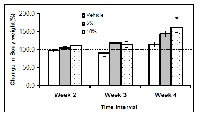Subchronic toxicity and behavioural effects of Glycine max (L.) oil emulsion in male rats
Keywords:
Glycine max, soyabean oil, locomotion, rearing, toxicity, ratsAbstract
The oil of Glycine max commonly known as soybean oil has over the decades grown popularity for its low cholesterol hence its use within the household and commercially for food production has grossly increased. This study was aimed to determine the effects of long term consumption of soybean oil toxicologically and behaviourally. Male albino rats were administered with the vehicle, 5 and 10% oil emulsion for 30 days orally. The rats were subjected to behavioural tests such as novelty-induced behaviour (NIB), learning and memory tests and food intake measurement weekly. At the end of 30 days, rats were anesthetized and carefully dissected and blood sample was taken and analyzed haematogically and biochemically. The liver sample was also taken for biochemical analysis. Histopathological examinations were carried out on the brain, spleen, liver, kidney, lungs and testis samples. The results showed that oral administration of oil caused an increase in food intake, significant effect on NIB but had no effect on learning and memory. There was a significant (p<0.05) reduction in the level of both haemoglobin and PCV in the grouped administered with high dose. Biochemical analysis revealed a significant (p<0.05) increase in triglyceride, ALT, AST levels, with no effect on cholesterol. Histopathological analysis revealed no significant effects on the essential organs tested when compared with the vehicle treated rats. This study conclusively showed that soybean oil has central excitatory effects and there is need for caution when used for a long period since it has significant effects on biochemical parameters.
References
Ajayi AA and Ukponmwan OE. Evidence
of angiotensin II and endogenous opioid
modulation of NIR in the rat. Afr J Med
Sci. 1994;23:287-90.
Akanmu MA, Adeosun SO and Ilesanmi
OR. Neuropharmacological effects of
oleamide in male and female mice. Behav
Brain Res. 2007;182:88-94.
Cury-Boaventura MF, Gorjão R, de Lima
TM, Piva TM, Peres CM, Soriano FG and
Curi RToxicity of a soybean oil emulsion
on human lymphocytes and neutrophils. J
Parenter Enteral Nutr. 2006;30(2):115-23.
Drago F, Contarino A, Busal L.The
expression of neuropeptide-induced
excessive grooming behavior in dopamine
D1 and D2 receptor-deficient mice. Eur J
Pharmacol. 1999;365:125-31.
Duke JA. Handbook of Energy crops.
Purdue University, Center for New Crops
and Plant Products. Last updated 2 July
URL:http://www.hort.purdue.edu/newcrop/
duke_energy/ dukeindex.html.
Ellman GL. Tissue sulfhydryl groups.
Arch. Biochem. Biophys. 1959;82:70-77.
Erickson DR, Pryde EH, Brekke OL,
Mounts TL, Falb RA. Handbook of Soy oil
Processing and Utilization, American
Soybean Association and the American Oil
Chemist’s Society. St. Louis, Missouri and
Chanpaign, Illinois 1980.
Evans WC. Pharmacognosy. 15th Edition.
W.B. Saunders . 2002;pp 188:294
Gutman J. Glutathione (GSH) Your
Body’s Most Powerful Protector. 3rd
edition. Kudo. CA communications.
;Pp 11-15:116
Ima-Nirwana S, Ahmad SN, Yee LJ, Loh
HC, Yew SF, Norazlina M, Abdul MT.,
Kamsiah J. Reheating of soy oil is
detrimental to bone metabolism in
oestrogen deficient rats. Singapore Med J.
;48(3):200-6.
Kumar P and Clark M. Clinical Medicine.
th edition. W.B. Saunders. 2002;pp
:337:410, 1106.
Lin JS, Chuang KT, Huang MS and Wei
KM. Emission of ethylene oxide during
frying of foods in soybean oil. Food Chem
Toxicol. 2007;45(4):pp. 568-74.
Lowry OH, Rosebrough NJ, Farr AL and
Randall RJ. Protein measurement with the
Folin phenol reagent. J. Biol. Chem
;193:265-275.
Nunes E, Peixoto F, Louro T, Sena CM,
Santos MS, Matafome P, Moreira PI.
Seiça R Soybean oil treatment impairs
glucose-stimulated insulin secretion and
changes fatty acid composition of normal
and diabetic islets. Acta Diabetol.
;44(3):121-30.
Reimold EW. Studies of the toxicity of an
intravenous fat emulsion. i. Hematologic
changes and survival after administration
of asoybean oil (FE-S15) in beagles. J
Parenter Enteral Nutr. 1979;3(5):328-34.
Rueda-Clausen CF, Silva FA, Lindarte
MA, Villa-Roel C, Gomez E, Gutierrez R,
Cure-Cure C, López-Jaramillo P. Olive,
soybean and palm oils intake have a
similar acute detrimental effect over the
endothelial function in healthy young
subjects. Nutr Metab Cardiovasc Dis.
;17(1):50-7.
Steckler T, Drunkenburg WH, Sahgal H,
Aggleton JP. Recognition memory in rats-I
concepts and classification. Prog
Neurobiol. 1998;54(3):289-311.
Zhao JH, Sun SJ, Horiguchi H, Arao Y,
Kanamori N, Kikuchi A, Oguma E,
Kayama F. A soy diet accelerates renal
damage in autoimmune MRL/Mp-lpr/lpr
mice. In Immunopharmacol
;5(11):1601-1610.



